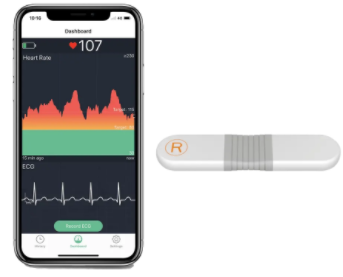Currently, there are a large number of modern technical means that allow almost every person to determine, without any extra effort and without the participation of a specialist, the frequency and rhythm of the pulse at rest and during physical activity.
It can be heart rate monitors(oximeters),pulse oximeters and some sensors what are built into sports watches, trackers, mobile phones.
The scale for determining the pulse rate and its regularity is also in most modern automatic devices for determining blood pressure (tonometer).
Looking for the Best Pulse Oximeter?
Let me tell you about the Wellue O2Ring – it’s like the superhero of pulse oximeters, seriously!
One of the coolest things about it is that it doesn’t just clip onto your finger like your average oximeter.
Nope, it’s a smart ring that you wear on your finger, making it super comfortable and convenient. You won’t even feel like you’re wearing anything special, yet it’s working its magic behind the scenes.
What sets the Wellue O2Ring apart from the pack is its continuous monitoring feature.
Most pulse oximeters just give you a snapshot of your oxygen saturation and heart rate, but this bad boy keeps tabs on your levels around the clock.
Whether you’re chilling on the couch, out for a jog, or catching those Z’s, it’s right there with you, providing real-time data.
Oh, and speaking of data, this thing doesn’t just show you numbers – it visualizes your trends over time too.
Imagine having a personal health diary that tells you when you’re acing life and when you might need to take it easy. It’s like having a health-conscious buddy right on your finger!
If you’re already itching to get your hands on the Wellue O2Ring (or, well, your finger in this case), I’ve got you covered.
Table of Contents
Heart Rate & Pulse – What’s the difference?
Not everybody knows that heart rate is not equal to the aspect of the pulse .
Heart rate (the number of times the heart beats per minute) is only one aspect of the pulse. Other aspects include rate of pressure increase, absolute pressure, and filling volume.
However, in a healthy person, the heart rate is almost identical to the pulse, so these terms are often used interchangeably.
But, in some pathological conditions, the pulse rate and heart rate may differ, the pulse rate may become less than the heart rate.
In this case, it is necessary to contact a specialist and conduct a comprehensive medical examination.
To track your heart rate, you need to remember two numbers: your resting heart rate and your maximum heart rate.
Resting heart rate is the value measured at rest, without any physical exertion. If you are in good health, it is usually between 50 and 100 beats per minute. If you are in great shape, it may even be lower.
The maximum heart rate is the beats per minute measured at maximum exertion.
The most common and convenient way to self-assess the pulse is to determine it on the radial artery, on the inside of the wrist from the side of the thumb or with the help of the pulse oximeter.
What Should the 2 readings On a Pulse Oximeter Be?
Sometimes pulse oximeters are confused with pulse monitors(heart rate monitors)because of the similar name.
The difference lies in the number of functions: if using a pulse oximeter you can track not only the pulse, but also the saturation of the blood with oxygen, then the heart rate monitor will show only the first indicator.

A good pulse oximeter has a clear display, bright LEDs and a photodetector. It is important to check that new batteries are inserted into the device – when the battery “sits down”, the device may give incorrect results.
What Should Heart Rate Look like on Oximeter?
Low indicators of the oximeter may not be related to the state of health. For the most accurate result, it is best to be warm and at rest during the measurement. It is recommended to perform the procedure several times.
Resting heart rate/pulse rate depends on many factors such as age, gender, body weight, average daily sleep duration, smoking, caffeinated beverages, physical activity level. Certain medications may affect the heart rate.
In children, normal heart rate values differ from those in adults and significantly depend on age, so in a child of 1-3 months, the heart rate is normally 145-170 beats / min., In 3-6 months – 130-150 beats / min, and at 6-12 months – 120-140 beats / min.
As they grow older, the heart rate decreases and, on average, in an adult (over 18 years old) at rest, it should be 60-90 beats per minute. In women, heart rate at rest is on average 6-10 beats per minute more often than in men.
A frequent pulse, more than 90 beats / min, is called tachycardia, a rare one, less than 60 beats / min, is called bradycardia.
At the same time, it should be noted that the heart rate at rest in a healthy person is variable and can normally fluctuate over time (day, week, month, year) in a fairly wide range, often going beyond the values accepted as normal, as well as beyond framework of the “individual norm”.
The heart rate at night, during sleep, slows down, after eating the rhythm quickens. In the afternoon, the heart rate gives two rises – the first around 11 o’clock in the afternoon, the second – between 6 and 8 o’clock in the evening.
Heart rate can also change with a sharp change in body position, with psycho-emotional stress. The heart rate also has small seasonal fluctuations, in winter the heart rate is on average higher than in summer.
For trained people who are actively involved in “aerobic”, cyclic endurance sports (skiing, swimming, marathon, cycling, etc.), resting heart rate is on average lower than that of an untrained person.
Alarming symptoms with a rare pulse are weakness, dizziness, fainting, pre-syncope. The appearance of these symptoms requires immediate medical attention.
Rule of thumb for calculating maximum heart rate
Men: 220 minus age
Women: 226 minus age
However, it must be taken into account that statistically averaged values are calculated using formulas, while individual values of maximum heart rate depend not only on age or gender.
As already mentioned, the degree of fitness and anthropometric indicators also affect the maximum heart rate.
Looking for a good Heart Rate Monitor?
Pay attention to Wellue Strap Free Heart Rate Monitor. It is a trusted manufacturer that has been making heart rate monitors with accurate measurements.
This manufacturer offers the latest and greatest and advanced features in heart rate monitoring.
From experience, Wellue Strap Free will be ideal 24/7 heart rate monitoring control during sports…

What is The Rhythm of the Heart Rate Monitor?
In a healthy person, the pulse is rhythmic, i.e., pulse waves follow one after another at regular intervals.
With heart rhythm disturbances (arrhythmias), pulse waves usually follow at irregular intervals, the pulse becomes arrhythmic.
In some cases, arrhythmia may be accompanied by a feeling of discomfort in the region of the heart, respiratory failure, a feeling of “tumbles”, blows to the chest, dizziness, and even loss of consciousness.
In this situation, it is advisable to contact a cardiologist to clarify the nature of cardiac arrhythmias and exclude cardiac pathology.
Does oximeter Show Correct Heart Rate?
Modern smart watches and pulse oximeters, heart rate monitors are equipped with an ECG recording function not only allow you to track your heart rate and give an idea of its rhythm, but can also detect some heart rhythm abnormalities
Many pulse oximeters show the heart rate, however, in some cases, the indicators of electrocardiography and pulse oximetry are different.
You should know that pulse oximeters are not designed to detect all abnormal heart rhythms and cannot be fully relied upon.
They can miss serious problems or cause people to worry unnecessarily about possible heart problems due to so-called “false positives“. In any case, only an examination by a specialist cardiologist can accurately determine the presence of cardiac arrhythmias and their nature.
Most hear rate monitors use the method of optical plethysmography (photoplethysmography). The method is based on the ability of blood to reflect red light and absorb green light.
An optical sensor on the back of the watch emits green light on the wrist using LEDs, and measures the amount of light scattered by the bloodstream, thus determining the blood flow on the wrist.
It is believed that optical sensors accurately determine the pulse, while walking and running.
However, measurements may become less accurate with a marked increase in heart rate, more than 150 beats per minute, in cold weather (due to reduced blood flow to the wrist).
There are other situations that can interfere with the operation of the sensor and lead to inaccuracies in measuring the pulse: having a tattoo on the wrist, loose fit of the watch to the skin, exercising in the gym.
Rhythmic movements, such as when running or cycling, provide more accurate results compared to tennis or boxing, where athletes move irregularly.
FAQ
Is pulse rate heart rate?
Not everybody knows that heart rate is not equal to the aspect of the pulse.
Heart rate (the number of times the heart beats per minute) is only one aspect of the pulse.
Other aspects include rate of pressure increase, absolute pressure, and filling volume.
However, in a healthy person, the heart rate is almost identical to the pulse, so these terms are often used interchangeably.
What does a normal heart rate look like on an oximeter?
A pulse of 50-55 beats per minute at rest, and sometimes 40-50 beats per minute, is considered normal for this category of adults and is not accompanied by any discomfort.
In an untrained person, such a heart rate is regarded as bradycardia and requires additional examination by a cardiologist.
Which finger is best for pulse oximeter reading?
The clip sensor is attached to the index finger of the hand. It is not recommended to simultaneously install the sensor and the cuff of a medical tonometer on the same limb, since in this case the result of the saturation measurement is distorted.
What are pulse oximeters and Heart Rate Monitors?
The difference lies in the number of functions: if using a pulse oximeter you can track not only the pulse, but also the saturation of the blood with oxygen, then the heart rate monitor will show only the first indicator.
